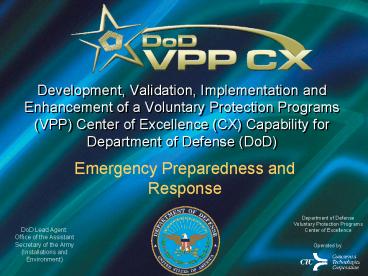Development, Validation, Implementation and Enhancement of a Voluntary Protection Programs VPP Cente
1 / 22
Title:
Development, Validation, Implementation and Enhancement of a Voluntary Protection Programs VPP Cente
Description:
Poorly developed plans lead to confusion and disorganization. Workplace Evaluation ... Bring attendance sheet. Conduct last sweep. Conduct roll call ... –
Number of Views:67
Avg rating:3.0/5.0
Title: Development, Validation, Implementation and Enhancement of a Voluntary Protection Programs VPP Cente
1
Development, Validation, Implementation and
Enhancement of a Voluntary Protection Programs
(VPP) Center of Excellence (CX) Capability for
Department of Defense (DoD)
- Emergency Preparedness and Response
Department of Defense Voluntary Protection
Programs Center of Excellence Operated by
DoD Lead AgentOffice of the Assistant
Secretary of the Army (Installations and
Environment)
2
Objectives
- After this training you will be able to
- Describe the Occupational Safety and Health
Administration (OSHA) and Voluntary Protection
Programs (VPP) Emergency Action Plan (EAP)
elements - Define some basic EAP requirements
- View the OSHA EAP eTool
3
Emergency Action Plan
- An EAP is a written document required by OSHA
standard 29 CFR 1910.38(a) - The purpose of an EAP is to facilitate and
organize employer and employee actions during
workplace emergencies - Well developed plans results in fewer employee
injuries and structural damage - Poorly developed plans lead to confusion and
disorganization
4
Workplace Evaluation
- When conducting a workplace evaluation for an EAP
make sure to include - Specific layouts
- Structural features
- Emergency systems
- Diverse representatives
- Commitment and support of all employees is
critical to the EAP success
5
Evacuation Plan
- Evacuation charts for all aspects of facility
should be designed and posted for all employees
to read - Monitors should be selected to assure evacuation
safety and accountability
6
Critical Employees
- Ensure critical employees have proper evacuation
training - Incorporate critical decisions into the EAP to
prepare employees for emergencies
Evacuation Training
7
Employee Meeting Place
- EAP should define emergency meeting place as well
as defining who should - Bring attendance sheet
- Conduct last sweep
- Conduct roll call
- Ensure second meeting place is defined in case
first one is inadequate
8
Rescue Duties for Employees
- Employees assigned to conduct rescue or other
efforts during an emergency should have access
to - Appropriate training (CPR, AED, etc.)
- Appropriate personal protective equipment
(PPE) such as vests, hard hats, etc. - Local fire departments or hospitals might provide
this service to small organizations
9
EAP Employee Contacts
- The EAP must include employee information who may
be contacted for additional information - The EAP must also be available, exercised and
critiqued by all employees
10
EAP Requirements
11
Emergency Announcement System
- An employer must have and maintain an employee
alarm system - Emergency announcement systems may include
- Loud speakers
- Alarms
- Voice
- Strobe lights
12
Exit Routes
- Exit routes must be
- A permanent part of the workplace
- Separated by fire resistant materials
- Adequately lighted
- Clearly visible and marked
- Free of decorations
13
Exit Routes
- During repairs, alterations or new construction
employees must not occupy a workplace unless the
exit routes are completed - If the direction of travel to the exit is not
immediately apparent, signs must be posted - Any doorway along the exit route which could be
mistaken for an exit must be marked with a Not
an Exit sign
14
Fire Prevention Plans
- The purpose of the fire prevention plan is to
prevent a fire from occurring in a workplace - Fire prevention plan must
- Be in writing
- Be kept in the work place
- Be available to all employees for review
15
Portable Fire Extinguishers
- Employees authorized to use portable fire
extinguishers must be trained in their use - The employer must ensure portable fire
extinguishers are maintained and tested at the
correct intervals
16
Fixed Extinguishing Systems
- Purpose of the fixed extinguishing system is to
quickly extinguish a developing fire and alert
occupants before extensive damage occurs - Employer is responsible for operating, testing,
and maintaining fixed extinguishing systems that
are installed to OSHA standards
17
OSHA EAP eTool
- http//www.osha.gov/SLTC/etools/evacuation/experts
ystem/question1.htm?allLinks
18
Summary
- In this session you learned about
- The OSHA and VPP EAP
- Some basic EAP requirements
- The OSHA EAP eTool
19
References
- Workplace evaluation 29 CFR 1910.38(b)
- Means of reporting fires and other emergencies
29 CFR 1910.38(c)(1) - Evacuation procedures and emergency escape route
assignments 29 CFR 1910.38(c)(2) - Procedures to be followed by employees who remain
to operate critical plant operations before they
evacuate 29 CFR 1910.38(c)(3)
20
References
- Procedures to account for all employees after an
emergency evacuation has been completed 29 CFR
1910.38(c)(4) - Rescue and medical duties for those employees who
are to perform them 29 CFR 1910.38(c)(5) - Names or job titles of persons who can be
contacted for further information or explanation
of duties under the plan 29 CFR 1910.38(c)(6)
21
References
- Design and construction requirements for exit
routes 29 CFR 1910.36 - Maintenance, safeguards, and operational features
for exit routes 29 CFR 1910.37 - Emergency action plans (EAP) 29 CFR 1910.38
- Fire prevention plans (FPP) 29 CFR 1910.39
- Portable fire extinguishers 29 CFR 1910.157
- Fixed extinguishing systems 29 CFR 1910.160
- Fire detection systems 29 CFR 1910.164
- Employee alarm systems 29 CFR 1910.165
22
Questions?































